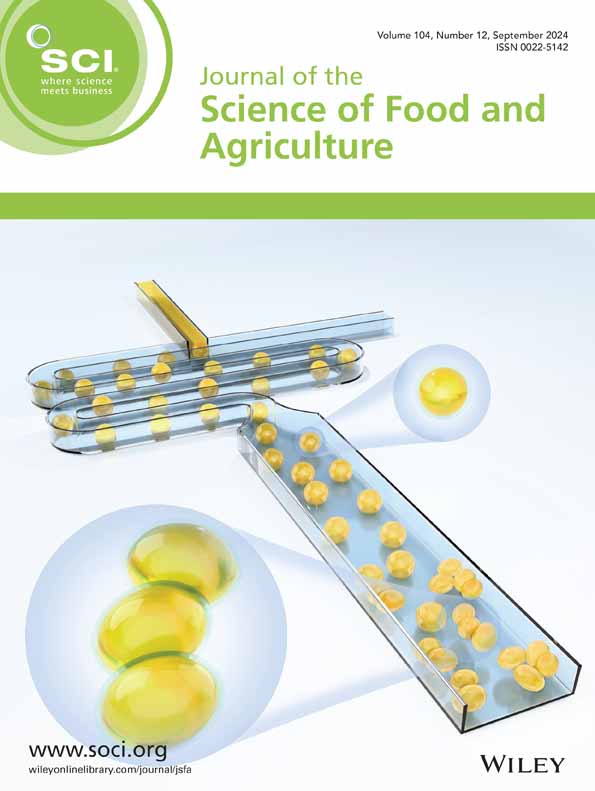求助PDF
{"title":"从农业废弃物中探索可持续营养的叶片蛋白质。","authors":"Charanjeet Kaur, Gurkanwal Kaur, Surekha Bhatia","doi":"10.1002/jsfa.70221","DOIUrl":null,"url":null,"abstract":"<p><p>The present review explores the potential of leaf proteins as a sustainable and affordable solution to meet the increasing global demand for dietary proteins, driven by the environmental impact of animal protein production and associated health concerns. Leaf proteins offer numerous functional benefits, including an essential amino acid profile, reduced allergenicity, enhanced foaming, emulsification and textural properties. The underutilized green leaves exhibit substantial variations from plant seeds in terms of protein quality, omega-3 and omega-6 fatty acid profiles, and vitamin and mineral concentration thus having a potential role in combating global malnutrition. The paper delves into the distribution of leaf proteins, eco-innovative methods for their extraction followed by their purification and modification techniques. It further discusses functional attributes and nutritional properties such as amino acid profiles, antioxidant potential and bioactivities of leaf proteins to understand their potential consideration for use in the food and nutraceutical industries. The review also highlights real-world paradigms of the potential application of leaf proteins along with their challenges and constraints to be used as functional food ingredients. Advancing research and development to combat antinutrients, production challenges and consumer acceptance of novel functional foods can thereby position leaf proteins as a pivotal resource in addressing global food security. This comprehensive review thus seeks to elucidate the transformative potential of leveraging agricultural waste to meet the protein needs of a rapidly growing population while fostering environmental sustainability and economic resilience. © 2025 Society of Chemical Industry.</p>","PeriodicalId":17725,"journal":{"name":"Journal of the Science of Food and Agriculture","volume":" ","pages":""},"PeriodicalIF":3.5000,"publicationDate":"2025-09-29","publicationTypes":"Journal Article","fieldsOfStudy":null,"isOpenAccess":false,"openAccessPdf":"","citationCount":"0","resultStr":"{\"title\":\"Exploring leaf proteins from agricultural waste for sustainable nutrition.\",\"authors\":\"Charanjeet Kaur, Gurkanwal Kaur, Surekha Bhatia\",\"doi\":\"10.1002/jsfa.70221\",\"DOIUrl\":null,\"url\":null,\"abstract\":\"<p><p>The present review explores the potential of leaf proteins as a sustainable and affordable solution to meet the increasing global demand for dietary proteins, driven by the environmental impact of animal protein production and associated health concerns. Leaf proteins offer numerous functional benefits, including an essential amino acid profile, reduced allergenicity, enhanced foaming, emulsification and textural properties. The underutilized green leaves exhibit substantial variations from plant seeds in terms of protein quality, omega-3 and omega-6 fatty acid profiles, and vitamin and mineral concentration thus having a potential role in combating global malnutrition. The paper delves into the distribution of leaf proteins, eco-innovative methods for their extraction followed by their purification and modification techniques. It further discusses functional attributes and nutritional properties such as amino acid profiles, antioxidant potential and bioactivities of leaf proteins to understand their potential consideration for use in the food and nutraceutical industries. The review also highlights real-world paradigms of the potential application of leaf proteins along with their challenges and constraints to be used as functional food ingredients. Advancing research and development to combat antinutrients, production challenges and consumer acceptance of novel functional foods can thereby position leaf proteins as a pivotal resource in addressing global food security. This comprehensive review thus seeks to elucidate the transformative potential of leveraging agricultural waste to meet the protein needs of a rapidly growing population while fostering environmental sustainability and economic resilience. © 2025 Society of Chemical Industry.</p>\",\"PeriodicalId\":17725,\"journal\":{\"name\":\"Journal of the Science of Food and Agriculture\",\"volume\":\" \",\"pages\":\"\"},\"PeriodicalIF\":3.5000,\"publicationDate\":\"2025-09-29\",\"publicationTypes\":\"Journal Article\",\"fieldsOfStudy\":null,\"isOpenAccess\":false,\"openAccessPdf\":\"\",\"citationCount\":\"0\",\"resultStr\":null,\"platform\":\"Semanticscholar\",\"paperid\":null,\"PeriodicalName\":\"Journal of the Science of Food and Agriculture\",\"FirstCategoryId\":\"97\",\"ListUrlMain\":\"https://doi.org/10.1002/jsfa.70221\",\"RegionNum\":2,\"RegionCategory\":\"农林科学\",\"ArticlePicture\":[],\"TitleCN\":null,\"AbstractTextCN\":null,\"PMCID\":null,\"EPubDate\":\"\",\"PubModel\":\"\",\"JCR\":\"Q1\",\"JCRName\":\"AGRICULTURE, MULTIDISCIPLINARY\",\"Score\":null,\"Total\":0}","platform":"Semanticscholar","paperid":null,"PeriodicalName":"Journal of the Science of Food and Agriculture","FirstCategoryId":"97","ListUrlMain":"https://doi.org/10.1002/jsfa.70221","RegionNum":2,"RegionCategory":"农林科学","ArticlePicture":[],"TitleCN":null,"AbstractTextCN":null,"PMCID":null,"EPubDate":"","PubModel":"","JCR":"Q1","JCRName":"AGRICULTURE, MULTIDISCIPLINARY","Score":null,"Total":0}
引用次数: 0
引用
批量引用

 求助内容:
求助内容: 应助结果提醒方式:
应助结果提醒方式:


